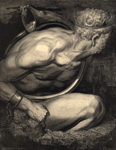
Giants: Circle 9, Inferno 31 The Giants physically connect circles 8 and 9: standing on the floor of circle 9--or perhaps on a ledge above the bottom of hell--the upper halves of their huge bodies tower over the inner edge of circle 8. From a distance, in fact, Dante initially mistakes the Giants for actual towers (Inf. 31.19-45). Anticipating the even larger figure of Lucifer, Dante's Giants--drawn from both biblical and classical stories--are archetypal examples of defiant rebels. Nimrod, described in the Bible as a "stout hunter before the Lord" (Genesis 10:9), was viewed as a Giant in the medieval tradition that Dante follows. According to the biblical account, people in the region ruled by Nimrod--Babylon and other cities in the land of Sennaar--plan to build a tower that will reach to heaven; God shows his displeasure by scattering the people and destroying the unity of their language so they will no longer understand one another's speech (Genesis 11:1-9). Dante, following tradition, places the blame for this linguistic confusion on Nimrod, whose own language is now as incomprehensible to others as their languages are to him (Inf. 31.67-9; 76-81). In his physical description of Nimrod, Dante reinforces the association of the Giants with the ruinous consequences of pride: 1) comparing the size of Nimrod's face to the pine cone at St. Peter's in Rome (Inf. 31.58-60), Dante perhaps means to draw an unflattering parallel with the current pope, Boniface VIII; 2) the word Dante uses--perizoma--to convey how the inner bank of circle 8 covers the lower half of the Giants' bodies like an "apron" (Inf. 31.61-2) is an unusual word (of Greek origin) likely familiar to Dante's readers from a biblical verse describing the shame of Adam and Eve following their disobedience in the Garden of Eden: "And the eyes of them both were opened: and when they perceived themselves to be naked, they sewed together fig leaves, and made themselves aprons [perizomata]" (Genesis 3:7). |